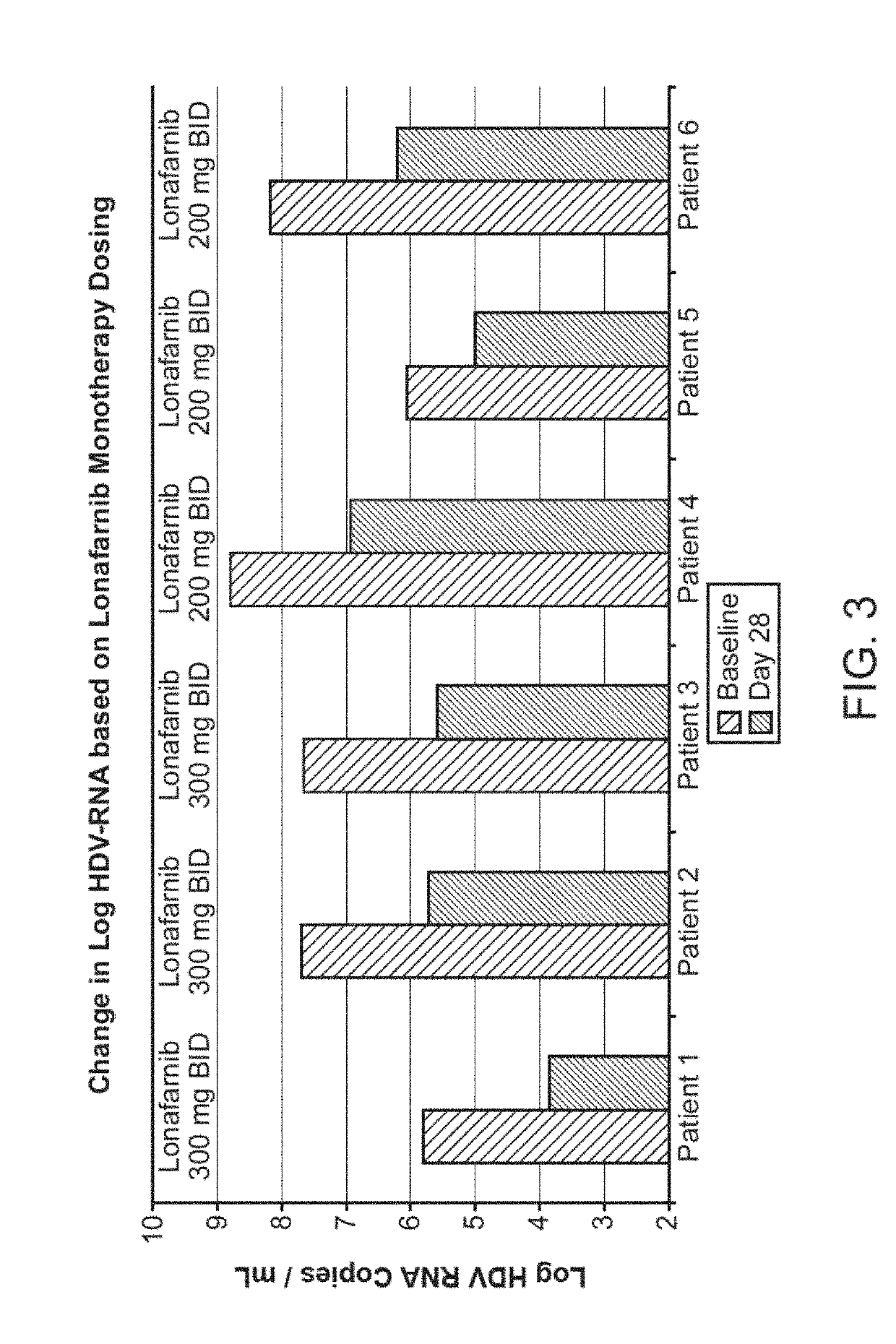Treatment of hepatitis delta virus infection
a technology treatment method, which is applied in the field of treatment of hepatitis delta virus infection, can solve the problems of insufficient reduction for development as a therapeutic, unacceptable level of adverse events, and serum levels of lonafarnib dropping after about one month of treatmen
- Summary
- Abstract
- Description
- Claims
- Application Information
AI Technical Summary
Benefits of technology
Problems solved by technology
Method used
Image
Examples
example 1
HDV Patients with 100 mg Lonafarnib Administered BID
[0260]This example demonstrates lonafarnib's efficacy to reduce HDV RNA levels in patients with chronic HDV. The eight Group 1 patients (all with chronic HDV) were treated as follows: 6 patients (patients 1, 2, 4, 5, 6, and 8) with chronic delta hepatitis (HDV) were treated with lonafarnib and 2 patients (patients 3 and 7) were administered placebo for a duration of twenty-eight days. The 6 patients in the active treatment group were dosed at 100 mg BID (orally administered) for 28 days. The mean change in HDV RNA levels from baseline to nadir in the lonafarnib active treatment group was −0.74 log HDV RNA copies / mL and in the placebo group was −0.24 log HDV RNA copies / mL.
[0261]Patients 4, 5, 6 and 8 were responsive to therapy, as defined by greater than or equal to a 0.5 log HDV RNA copies / mL decline in quantitative serum HDV RNA levels from baseline to nadir during active treatment. See Table 6 (showing change in HDV RNA viral loa...
example 2
HDV Patients with 200 mg and 300 mg Lonafarnib Administered BID
[0264]Six human subjects known to be infected with HDV, as documented by baseline HDV RNA viral titers ranging from 5.8 log HDV RNA copies / mL to 8.78 log HDV RNA copies / mL, were treated with lonafarnib at doses of either 200 mg BID or 300 mg BID for a period of 84 days.
Effect of 28 Days Treatment
[0265]At the end of 28 days of treatment, the mean change in viral load across the six subjects from baseline to day 28 was −1.63 log copies / mL for the 200 mg BID group and −2.00 log copies / mL for the 300 mg BID group. See Table 7 and FIG. 3.
TABLE 7300 mg BID200 mg BIDlonafarniblonafarnibPatientPatientPatientPatientPatientPatient123456HDV RNA5.87.77.668.786.068.19viral loadbaseline (logcopies / mL)Δ log Baseline−1.95−1.97−2.07−1.85−1.06−1.98to Day 28
[0266]The results at Day 28 demonstrated superior efficacy of the 200 mg BID and 300 mg BID administration schedule over the 100 mg BID administration schedule. However, additional effi...
example 3
on Treatment of HDV Patients with 100 mg BID Lonafarnib and Interferon
[0268]Three human subjects known to be infected with HDV, as documented by baseline HDV RNA viral titers ranging from 4.34 log HDV RNA copies / mL to 5.15 log HDV RNA copies / mL and ALT values ranging from 155-174 IU / L, were treated with lonafarnib in doses of 100 mg BID in combination with Pegasys® (peg interferon alfa-2a) 180 μg per week for a period of 56 days (2 months).
[0269]At the end of 28 days, all three patients' HDV RNA viral titers had decreased from baseline, ranging from −1.04 log HDV RNA copies / mL to −2.00 log HDV RNA copies / mL drop in HDV-RNA, with an average drop across the three subjects of −1.8 log HDV RNA copies / mL. At the end of 56 days, all three patients' HDV RNA viral titers continued to decline with a mean viral load decline of 3 log copies / mL at day 56. In addition, the ALT values of all three patients decreased from baseline through day 56, continuing to decline after therapy was stopped, no...
PUM
| Property | Measurement | Unit |
|---|---|---|
| concentration | aaaaa | aaaaa |
| concentration | aaaaa | aaaaa |
| concentration | aaaaa | aaaaa |
Abstract
Description
Claims
Application Information
 Login to View More
Login to View More - R&D
- Intellectual Property
- Life Sciences
- Materials
- Tech Scout
- Unparalleled Data Quality
- Higher Quality Content
- 60% Fewer Hallucinations
Browse by: Latest US Patents, China's latest patents, Technical Efficacy Thesaurus, Application Domain, Technology Topic, Popular Technical Reports.
© 2025 PatSnap. All rights reserved.Legal|Privacy policy|Modern Slavery Act Transparency Statement|Sitemap|About US| Contact US: help@patsnap.com



